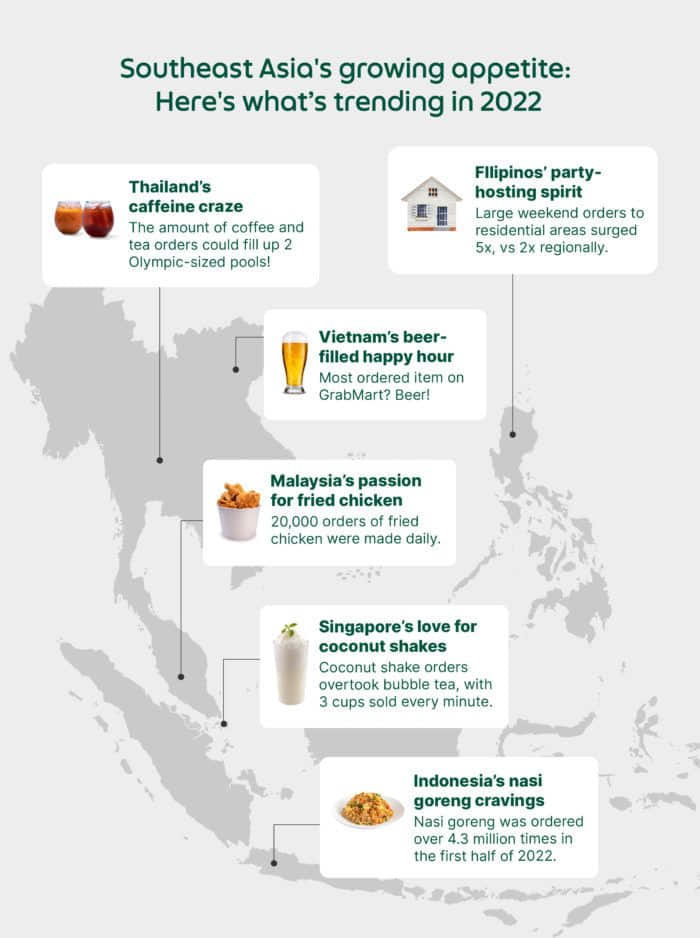In a region known for its street food, hawker cuisine and an amalgamation of cultural and culinary influences, more people are choosing to get their food delivered to the home.
About 70 per cent of consumers in Southeast Asia view delivery as a permanent part of their post-pandemic lives, according to Grab’s latest Southeast Asia (SEA) Food and Grocery Trends 2022 report.
One in 20 consumers in the region of 680 million use Grab at least once a month.
GrabFood and GrabMart consumers ordered about 1.5 times more often in 2022 than they did in 2019 and 2020, respectively. Singapore consumers spent the most on deliveries, while Vietnamese consumers made the most number of orders.
While the pandemic’s initial spike in demand for online food and grocery delivery services has eased, it seems the habit of ordering online has stuck.
Consumers are accustomed to paying for delivery fees in exchange for the convenience and comfort of having food sent to their doorstep. For example, those in Malaysia, Thailand and Indonesia tend to order in to avoid long queues or crowds.
They are spending more per order too. The average basket size on GrabFood this year was up 18 per cent from 2019 while that on GrabMart grew 28 per cent from 2020. Overall, expenditure on food and grocery delivery went up 1.3 times between 2021 and 2022.

The most frequent users of delivery services were young families with children, particularly in Indonesia. Consumers who are married with kids made up some 81 per cent of heavy delivery app users in Indonesia.
This is the same across the region where users who are married with kids made up a bulk of heavy delivery app users in Vietnam (74 per cent), Malaysia (62 per cent), Singapore (60 per cent), Thailand (58 per cent), the Philippines (55 per cent).
On average, this group orders food more than 6 times a month and orders groceries over 10 times a month.
Party plates and plant-based dishes
Sharing plates and finger food were the most commonly ordered for large gatherings — reflective of communal dishes that are an essential part of Southeast Asian cuisine.
This comes as some two in five consumers say that they prefer dining and entertaining guests at home instead of heading out for social gatherings. There were twice as many large weekend GrabFood orders from residential areas across the region between 2020 and 2022.
Sharing plates and finger food were the most commonly ordered for large gatherings — reflective of communal dishes that are an essential part of Southeast Asian cuisine.
The Philippines emerged as the biggest party hosts with five times more large-sized weekend orders over the same period of time.
Asian consumers are also shifting to healthier lifestyles and consumption habits. The demand for healthy meals was up by at least two times across the region.
Many are replacing dairy and meat with plant-based alternatives. One in two Southeast Asians have tried plant-based options in the first six months of the year. They generally opted for healthier foods during lunch time compared to any other parts of the day.
That said, the region is not giving up post-meal sweet treats and light bites with some two in five consumers snacking at least once a day. Over 60 per cent of consumers said they tend to order snacks for more than one person each time as more people return to work.
Consumers in Thailand and the Philippines snacked the most often.
Consumers in Thailand and the Philippines were the biggest snackers, snacking at least four times a week compared to the regional average of thrice a week.
Ice cream, chips, cakes and chocolates were among trending snacks on GrabFood across the region.

3 Media Close,
Singapore 138498
Komsan Chiyadis
GrabFood delivery-partner, Thailand
COVID-19 has dealt an unprecedented blow to the tourism industry, affecting the livelihoods of millions of workers. One of them was Komsan, an assistant chef in a luxury hotel based in the Srinakarin area.
As the number of tourists at the hotel plunged, he decided to sign up as a GrabFood delivery-partner to earn an alternative income. Soon after, the hotel ceased operations.
Komsan has viewed this change through an optimistic lens, calling it the perfect opportunity for him to embark on a fresh journey after his previous job. Aside from GrabFood deliveries, he now also picks up GrabExpress jobs. It can get tiring, having to shuttle between different locations, but Komsan finds it exciting. And mostly, he’s glad to get his income back on track.

